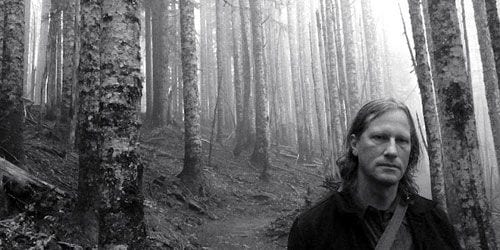
For the past 25 years, abstract sound composer Daniel Menche has been making challenging and often unclassifiable noise. The Portland, Oregon-based artist has collaborated with KK Null, Kevin Drumm, John Weise, Sunn O))) and many others, and recorded for labels such as Sub Rosa, Alien8, Important and Editions Mego (Editions Mego recently releasing 40 minutes of magnificent clatter with Menche’s Marriage of Metal). Drone, skewed configurations, structured ambience and unstructured pandemonium all play a role in Menche’s work, and his discography is intimidating in size, volume and depth of experimentation.
Although uncertainty and subversion certainly play their part in Menche’s oeuvre, his transformations and reconfigurations of sound provide a clear, focused route to emotional fulfillment and purgation. Menche is bent on investigating the possibilities of noise, but there’s nothing clinical or detached in that exploration. The intensity of his work shouldn’t be mistaken for directionless chaos. It has an end goal of provoking (and stimulating) the listener’s own imagination, and engages because it is organic. His sound inquiries may launch into inventive galaxies of noise, but a recurrent biological pulse always remains.
Menche’s latest release, Vilké, is his first for SIGE Records, and explores the biotic and our gut reaction to our interconnectedness with nature and the animal instincts. Created with drums, guitars, piano and wolves (yes, you read that right), Vilké — a Lithuanian word for the female wolf — was inspired by Menche’s hikes into the wilderness and the howls that accompanied his overnight sojourns. Those howls are the primary sonic element on Vilké, with Menche layering, interweaving and elongating the Canis lupus laments into four eerie and long-form choral compositions — all hovering around 20 minutes in length. (The double LP is also housed in a deluxe sleeve, with beautiful artwork courtesy of SIGE records co-founder, Faith Coloccia.)
Vilké is a sustained, often subdued exploration, rather than a grisly collision of noise. It begins with the somber immersion of “Part One”, where darkness descends over the backwoods, luring you into twilight’s beauty and unease. In “Part Two”, the stars come out as serenades of shimmering tones streak the sky, while the underlying escalating static reemphasizes the wonderment and fear that exists in darkened forests.
On “Part Three”, the deconstruction arrives. Poly-rhythmic and propulsive percussion sets the tempo, with a driving, glitchy heartbeat rising from the loam. The buzz and hiss of “Part Four” grants a sense of mother nature’s inherent danger, and the cacophony of voices that speak of worlds far outside human understanding — the tooth and claw world of the dying fox’s universe from Lars von Trier’s Antichrist seems to be an apt visualization.
There’s a strong sense of the unseen to Vilké, and of course a great deal of accompanying unease. Still, for all the album’s menacing distortions, Vilké isn’t terrifying, at least not in the conventional sense, which is apt given Menche’s unconventionality. Where many of Menche’s previous albums, such as GUTS or Feral, are audio assaults, packed with visceral dissections of sound, Vilké is subtle in its approach. It creeps and stalks, much like a wolf tracking its prey, with the same sense of unnerving, furtive flickers of movement from the corner of your eye–or in this case, your ear.
Menche has always maintained a strong sense of determination in his work. He wanders into the hinterlands of strident noise to seek out often disconcerting sounds, but there’s nothing vague or unintelligible about his purpose. Vilké tells a coherent tale and follows a distinct pathway — albeit one lit by moonlight rather than blazing lamps.
The detail in Vilké is what counts most. The album transitions from menace to warmth (and back to menace) using shifts in texture and timbre to make maximum use of what is often a minimalist sound palette. Menche has clearly thought deeply about how to twist and tweak the wolves’ howls and combine it with forbidding sounds to create the unsettling. However, there’s nothing gratuitous about that. There’s a strong sense that Menche seeks to amplify the message in that howl — insofar as we as humans can ever hope to understand it.
Vilké may well be a conceptual work, but there’s nothing theoretical about its impact or resonance because it evokes a primal and deep-set response. It conjures the mood and atmosphere of the pack and, in doing so, speaks to the animal in all of us. Of course, as humans we will never truly know the heart or mind of the wolf, but Vilké certainly paints a vivid picture of where our base instincts meet.

![Call for Papers: All Things Reconsidered [MUSIC] May-August 2024](https://www.popmatters.com/wp-content/uploads/2024/04/all-things-reconsidered-call-music-may-2024-720x380.jpg)



